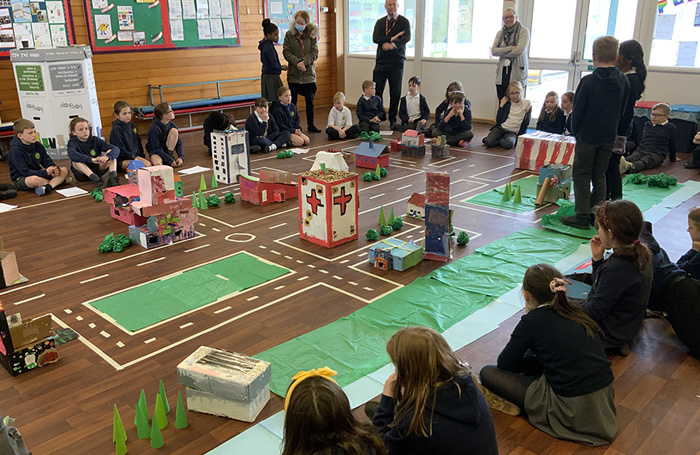If young people from disadvantaged backgrounds do not know what an architect does, the profession will never become more diverse.
That is the main reason why so many practices engage with schools, youth clubs and mentoring schemes. All practices should consider outreach with schools: it introduces new possibilities to young people.
But there are a host of other benefits too, from staff wellbeing and job satisfaction to the good PR resulting from doing something good for the community.
It also demonstrates provision of social value at a time when evidencing social value creation is, rightly, being increasingly requested by a range of clients.
Hawkins\Brown has engaged with schools for many years. Often there might be a direct connection to a project they have carried out. Sometimes they might be approached by an organisation. The practice was also one of the first to sign up to the RIBA National Schools Programme, which pairs practices with schools.
Xuhong Zheng is an Associate at Hawkins\Brown who has run many practical workshops for children and young people.
“It’s a rewarding experience and a break from the day-to-day,” she enthuses. “I think that has real value in terms of staff retention.”
It’s not always easy to put down on paper concrete examples of how your practice has been delivering social value, but workshopping with schools and mentoring older pupils are clearly valuable outputs. This can even play a role in winning work.
“That's not the motivation for our schools work,” Zheng states. “But with almost every bid we’re doing for the public sector, there is a social value question. A lot of what we do with schools will be written about in those answers.”
So what might be stopping more practices from doing it?
Time might be one perceived barrier, suggests Zheng. But schools outreach need not be complicated. It might be as simple as a quick ‘show and tell’ about what you do at a school assembly. Small practices might not appreciate how much impact just a simple introduction to architecture might have.
Zheng’s colleague at Hawkins\Brown, Praneet Bhullar, points out that small practices shouldn’t think workshops have to create fabulous objects made with beautiful materials. Really successful workshops can be organised with minimal cost and resources.
Recycled materials work well for some circular economy thinking. Bhullar recalls asking for leftover tubes at the local carpet shop: great for model making.
Rory Harmer, Managing Director at Studio Becoming has run workshops for pre-school children all the way up to 18-year-olds in schools, Open City events and at the RIBA.
Harmer likes to start simply. A good prompt to get young people thinking like an architect is to ask them to draw a space. That might be the room they are in, or their bedroom.

“If they're in a classroom, they might draw the classroom in scale on some gridded paper,” he explains.
“Or they might draw their dream bedroom. They start with a door, a bed and a desk but then they become interested, get creative and start adding slides and all sorts of features.”
Reimagining the local high street also works well. They are engaging with what they know, but doing something that professional architects do: adding a zoo was a popular option for one class. Taking classes outside can be inspiring. One workshop involved pupils making models for treehouses, after they had learned how to draw a plan, a section and an elevation.
Harmer has just won a competition to design the new headquarters for the Egypt Exploration Society. At a two-day workshop hosted by RIBA Learning in August for 15-18 year olds, he will use it as a model to show how projects progress. Participants will be challenged to design a part of the headquarters. He has invited the director of some exploration sites in Egypt to review the results.
Pupils will also often come up with inspiring new ideas in workshops. Zheng’s own research projects have been enriched by the input of young people, such as relationships between light and wellbeing and the experience of spaces.
She was able to explore this with pupils, making light models in creative workshops, and listening to their suggestions.
When workshops can be linked to core parts of what the practice is about, or actual projects, staff can find them particularly rewarding. In one primary school where Hawkins\Brown had helped to develop the school itself and a residential element next door, the workshops effectively turned into a playful quasi-Post Occupancy Evaluation exercise.
Feedback was gathered from students, teachers and the headteacher on how the building was being used, which bits had been most successful, and which bits hadn’t worked quite as expected.
“That has been a unique opportunity to get feedback in a more creative way, rather than the standard POE reports with bar charts and pie charts,”’ adds Bhullar.
Thanks to Xuhong Zheng, Associate and Praneet Bhullar, Architect at Hawkins\Brown; Rory Harmer, Managing Director, Studio Becoming.
Text by Neal Morris. This is a Professional Feature edited by the RIBA Practice team. Send us your feedback and ideas
RIBA Core Curriculum topic: Architecture for social purpose.
As part of the flexible RIBA CPD programme, professional features count as microlearning. See further information on the updated RIBA CPD core curriculum and on fulfilling your CPD requirements as an RIBA Chartered Member.









